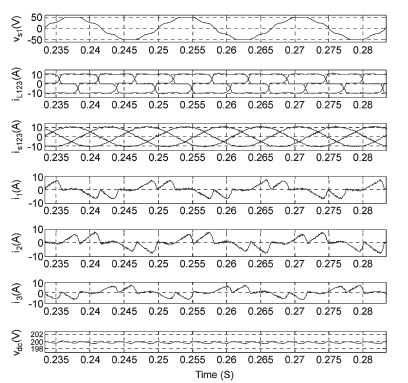ABSTRACT
This paper presents a nonlinear control technique for
a three-phase shunt active power filter (SAPF). The method provides
compensation for reactive, unbalanced, and harmonic load current components. A
proportional–integral (PI) control law is derived through linearization of the
inherently nonlinear SAPF system model, so that the tasks of current control
dynamics and dc capacitor voltage dynamics become decoupled. This decoupling allows
us to control the SAPF output currents and the dc bus voltage independently of
each other, thereby providing either one of these decoupled subsystems a dynamic
response that significantly slower than that of the other. To overcome the
drawbacks of the conventional method, a computational control delay
compensation method, which delaylessly and accurately generates the SAPF reference
currents, is proposed. The first step is to extract the SAPF reference currents
from the sensed nonlinear load currents by applying the synchronous reference
frame method, where a three-phase diode bridge rectifier with R–L load
is taken as the nonlinear load, and then, the reference currents are modified, so
that the delay will be compensated. The converter, which is controlled by the
described control strategy, guarantees balanced overall supply currents, unity
displacement power factor, and reduced harmonic load currents in the common
coupling point. Various simulation and experimental results demonstrate the
high performance of the nonlinear controller.
KEYWORDS:
1.
Active power
filter
2.
Control delay
compensation,
3.
Modeling
4.
Nonactive load
current compensation
5.
Nonlinearc
control
6.
Power quality.
SOFTWARE: MATLAB/SIMULINK
BLOCK
DIAGRAM:
Fig. 1. Basic circuit of SAPF.
EXPECTED SIMULATION RESULTS:
Fig. 2. Steady-state response of
the SAPF.
Fig.
3. Spectrum of phase 1. (a) Load current. (b) Source current after
compensation.
Fig.
4. Dynamic response of SAPF under varying distorted nonlinear load
conditions.
Fig. 5.
Steady-state response of SAPF with nonlinear load unbalances.
Fig.
6. Spectrum of load currents and source currents after compensation for
asymmetrical
load conditions.
CONCLUSION
The
nonlinear control algorithm of an SAPF has been implemented to enhance its
response for compensation of nonactive load currents. The nonlinear control
technique of the SAPF has been designed, which is based on two inner current
loops and an outer dc bus voltage regulator loop. It addition to good performance in both
steady-state and transient operations. Simulation and experimental results have
validated the nonlinear control approach of the SAPF. It has been shown that the
system has 1.5 cycles for the outer voltage loop and 0.5 cycles for the inner
current loop and is able to keep the THD of the supply current below the limits
specified by the IEEE- 519 standard. The obtained results have demonstrated the
high performance of the SAPF.
REFERENCES
[1] S.
Senini and P. J. Wolfs, “Hybrid active filter for harmonically unbalanced three
phase three wire railway traction loads,” IEEE Trans. Power Electron.,
vol. 15, no. 4, pp. 702–710, Jul. 2000.
[2] S.
Rahmani, K. Al-Haddad, H. Y. Kanaan, and B. Singh, “Implementation and
simulation of a modified PWM with two current control techniques applied to a
single-phase shunt hybrid power filter,” Proc. Inst. Elect.
Eng.—Electr. Power Appl., vol. 153, no. 3, pp. 317–326, May 2006.
[3] B.
Singh, V. Verma, and J. Solanki, “Neural network-based selective compensation
of current quality problems in distribution system,” IEEE Trans. Ind.
Electron., vol. 54, no. 1, pp. 53–60, Feb. 2007.
[4] B.
R. Lin and C. H. Huang, “Implementation of a three-phase capacitor clamped active
power filter under unbalanced condition,” IEEE Trans. Ind. Electron.,
vol. 53, no. 5, pp. 1621–1630, Oct. 2006.
[5] R.
Grino, R. Cardoner, R. Costa-Castello, and E. Fossas, “Digital repetitive control
of a three-phase four-wire shunt active filter,” IEEE Trans. Ind. Electron.,
vol. 54, no. 3, pp. 1495–1503, Jun. 2007.
.


































